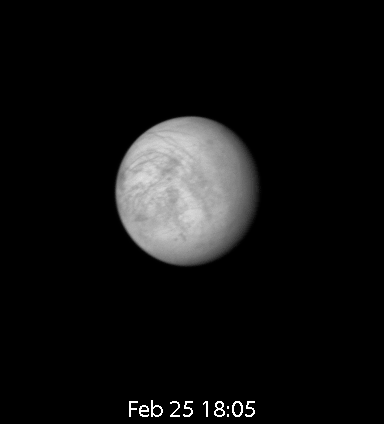Emily Lakdawalla • Apr 02, 2007
Io and Europa glimpsed by a retreating New Horizons
This image is beautiful for many reasons. It was captured by the MVIC imaging spectrometer, part of the Ralph instrument, on New Horizons, as it left the Jupiter system on March 2, 2007.

What you are looking at is two moons of Jupiter, Io and Europa, both in crescent phase, as New Horizons has passed by Jupiter and now must look back toward the inner solar system and the Sun to see it. Europa appears to be the larger of the two, but that's an optical illusion because of their different distances from the spacecraft: larger Io (3,630 kilometers in diameter) is 4.6 million kilometers from New Horizons, while smaller Europa (3,122 kilometers in diameter) is closer at 3.8 million kilometers away.
It's easy to spot which one is Io from the erupting Tvashtar plume, shining blue near Io's north pole. There are two smaller plumes visible, Prometheus at the 9 o'clock position and Amirani in between Prometheus and Tvashtar just on the night side of the terminator. You can even see the glow from hot lava at the base of the Tvashtar plume.
One very strange thing about this image is the difference between the night sides of Io and Europa: Io's is lit, with surface features visible, while Europa's is not. How the heck is that possible? The answer, again, has to do with their different distances from New Horizons, which in turn has to do with their respective positions on their orbits around Jupiter. When this image was taken, Io was on the far side of Jupiter from New Horizons, while Europa was closer to Jupiter than New Horizons. Being on the far side of Jupiter, Io's night side is lit by sunlight reflected off of Jupiter's cloud tops. Europa's night side is not, because the side of Europa that is receiving reflected light from Jupiter is the side that is facing away from New Horizons.
But I think that the most notable thing about this image was that it was not taken for scientific purposes; this particular image was one of seven "Kodak moments" in the Jupiter flyby that were added to the sequence for their aesthetic value. And that's not all. The science team, being very busy in their preparations for the encounter, didn't have time to work through the encounter geometry to search for good "Kodak moment" opportunities, but they didn't want to miss their chance to take some truly pretty pictures. So they invited the amateur community to use the public information about New Horizons' flyby trajectory to find and suggest good opportunitites to take pretty pictures. This particular Kodak moment was suggested by space enthusiast Richard Hendricks. These kinds of pictures are of the greatest benefit to the public -- it seems fitting that it's a member of the public who did the work to find out and suggest to the New Horizons team when to take them.
Like last week's picture of Io, this one was also taken as part of a multi-instrument observation that should also have included higher-resolution LORRI images; I don't see those on the New Horizons website yet, but once they are posted I should be able to make a more detailed color picture. Stay tuned for that!
In the meantime, here is an animation of the seven observations of Europa that have been released so far on the New Horizons website. There should be five more coming -- this is just a teaser of what's to come. (Note -- if you're looking at this image weeks or months after I originally posted this blog entry on April 2, 2007, I do plan to replace it with a more complete version once all the images are returned, so if you're lucky you'll see all twelve.)



 Explore Worlds
Explore Worlds Find Life
Find Life Defend Earth
Defend Earth

